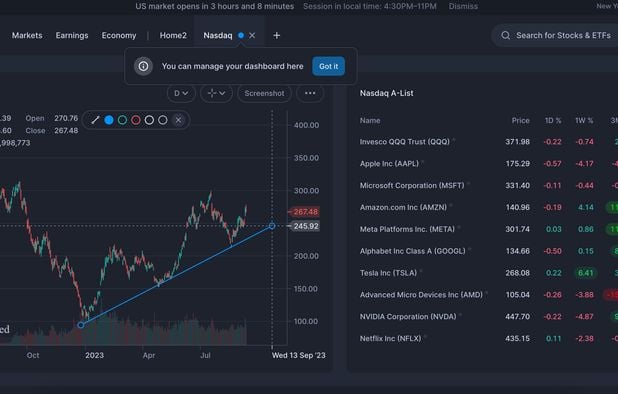20 Excellent Advice On Picking AI Stock Predictions Analysis Websites
Wiki Article
Top 10 Tips On Assessing The Security And Privacy Of Ai Analysis And Stock Prediction Platforms
Security and privacy of trading platforms that are based on AI are important, since they handle financial and personal information. A breach of data or misuse of data can cause financial loss and reputational damage. Here are 10 best guidelines to determine the privacy and security of these platforms.
1. Consider Data Encryption
Secure transmission of data Verify that the platform is using secured protocols (e.g. TLS/SSL) that encrypt the data that is transferred between your device and their servers.
In-rest encryption: Check that sensitive data stored on platform servers are encrypted with the help of high-quality encryption standards.
End-to-end encryption: Check if your platform provides encryption from beginning to end for sensitive data and communications. are highly sensitive.
2. Assess the authenticity methods
Two-factor authentication (copyright). It is important to ensure that the application you're using supports copyright. This adds another layer of security.
Verify biometric authentication.
Password policies. Check if the platform has policies on passwords that are secure (e.g. minimum length, complexity requirements).
3. Examine for Compliance with Regulations
Financial regulations: Make sure you are in compliance with the relevant financial regulation (e.g. SEC FINRA MiFID II).
Law on data protection: If you trade with a region that is legally governed by these laws, make sure you are in the compliance.
Audit certifications. Check that the platform you're considering has been through third-party assessments of security or has been certified.
4. Review the Data Access Controls
Role-based access: Ensure the platform is using role-based access controls (RBAC) to limit data access to authorized users.
Verify whether you can set permissions at granular levels for various team members.
Activity monitoring: See if the platform logs and monitors user activities to identify suspicious behaviour.
5. Assess the vulnerability of your organization.
Regular updates: Ensure your platform is updated regularly its software in order to fix weaknesses.
Penetration testing: Verify that the platform has been subjected to regular penetration testing to identify and correct security vulnerabilities.
Bug bounty programs: Check if there is a bug-bounty program on the platform to motivate security researchers from outside to disclose weaknesses.
6. Evaluate Data Privacy Policies
Transparency Check out the privacy policy to see how your data are collected, used, or shared.
Data minimization is a method of ensuring that only data necessary for operation are gathered by the platform.
Third-party sharing: Check if the platform shares data with third-party providers and, if it does in what manner.
7. Secure API usage must be checked
API security: Make sure that the platform's API utilizes secure authentication (e.g. OAuth, API Keys) and encrypts every data exchange.
Rate-limiting: Check if the API has a limit on rate to stop abuse and brute force attacks.
Find out if the platform records API access for monitoring, auditing and reporting.
8. Assess Incident Response, Recovery
Plan for incident response: Make sure the platform has a solid plan for handling data breaches and security incidents.
Notification policies: Check whether the platform informs users immediately in the event of a security breach.
Backups of data: Make sure the platform regularly backups the data it stores and has a disaster recovery strategy in place.
9. Assess physical security measures
Data center Security: Make sure that servers are located in secure data centers, with physical security measures (e.g. monitoring, access controls).
Redundancy - Verify that the platform is armed with redundant systems in order to guarantee data availability even if hardware fails.
Geographic distribution: Verify that the data is distributed to different geographical locations to improve the resilience.
10. Test privacy safeguards for users
Data deletion: Make sure that the platform allows you to permanently erase your personal information when you stop using the services.
Privacy settings: Make sure to check whether the platform has privacy settings to limit the data that is public or shared.
Check for anonymization. This is important if you are using the platform for analytics or machine-learning.
Bonus Tips
User reviews and reputation - Research the reviews and feedback of users to understand the level of security and privacy a platform.
Trial time: You can make use of a demo or a no-cost trial to try the privacy and security controls.
Customer support: Make sure that the platform offers a robust customer support for any security-related issues or concerns.
You can assess the privacy, security as well as the accuracy of AI platforms for trading stocks by following these guidelines. This will ensure that your financial data and personal information are secure. Secure platforms not only protect your assets, but it will also build confidence and trust in its products. See the recommended lowest price on investment ai for more recommendations including best ai for trading, using ai to trade stocks, ai stocks, ai for stock predictions, ai investing app, ai investment platform, ai investing platform, ai for investment, ai trading tools, ai stock trading app and more.

Top 10 Tips On Assessing The Regulatory Compliance For Ai Stock Predicting Trading Platforms
The regulatory compliance of trading platforms using AI to predict/analyze the price of stocks is a significant factor. Compliance assures that a platform adheres to financial regulations and is operating within legal frameworks, and safeguarding user information. This minimizes the chance of financial penalties or legal concerns. Here are top 10 tips on how to assess the level of compliance these platforms have.
1. Verify the License and Registration
Regulatory bodies : Verify that the platform is registered and licensed by the appropriate financial regulatory authority (e.g. SEC, FCA, ASIC, etc.) in your nation.
Broker partnership: If the platform integrates with brokers, ensure that the brokers are licensed and properly regulated.
Public records: Go to the website of the regulator to check on the status of registration, as well as the history of violations.
2. Compliance with the Data Privacy Evaluation
GDPR - If your website operates within the EU or serves users from the EU ensure that it is compliant with GDPR.
CCPA: California Consumer Privacy Act compliance is mandatory for users.
Data handling policies. Check the privacy policies and ensure that it clarifies the manner in which user data is collected, shared and stored.
3. Evaluating Anti-Money Laundering / AML measures
AML Policies: Make sure the platform has AML policies that are able to stop and detect money laundering.
KYC procedures: Verify whether the platform is following Know Your Customer (KYC) procedures for verifying identity of the user.
Transaction monitoring You can find out if the platform is monitoring all transactions for suspicious activities and informs authorities.
4. Verify compliance with Trading Regulations
Market manipulation: Check that the platform is equipped with measures to prevent manipulation of the market, for example, spoofing and wash trading.
Types of orders. Examine if your platform complies with the rules for orders.
Best execution: Ensure that the platform follows the most efficient execution procedures to ensure that trades are executed at the highest price.
5. Cybersecurity Assessment
Data encryption: Ensure that the platform protects data during transit and while at rest by encrypting it.
Response to incidents. Verify whether the platform has a plan of action to handle cybersecurity breaches and data breaches.
Certifications: Find out if a platform has been accredited for cybersecurity (e.g. ISO 27001, SOC 2)
6. Transparency & Disclosure:
Fee disclosure: Ensure the platform clearly outlines all fees, including any hidden or additional charges.
Risk disclosure: Make sure the platform provides clear risks and disclosures. This is particularly important for trading strategies with high leverage or risk.
Performance reporting: Find out whether the platform is clear and accurate reports on performance on its AI models.
7. Verify that you are in compliance with International Regulations
Transparency in trading across borders When you trade internationally, ensure that the platform is compliant with all regulations.
Tax reporting: Check if the platform provides tools or reports to aid users in complying with tax laws (e.g., FIFO rules in the U.S.).
Compliance with international sanctions: Be sure your platform is in strict compliance with these and doesn't allow trading with prohibited entities or countries.
8. Assess Record-Keeping & Audit Trails
Transaction records: Make sure your platform has detailed records of every transaction, both for regulatory and auditing purposes.
Logs of activity for users (logs) The logs contain information about user activity. check if the platform records the activities of users, such as trading and logins. Also, make sure that the account settings have altered.
Audit readiness: Make sure that the platform is able to provide all documents and logs in the event of an audit by a regulatory agency occurs.
9. Assess compliance with AI-Specific Regulations
Algorithmic rules for trading: If your trading platform supports algorithms, check that it is in compliance with the rules of MiFID II for Europe or Reg. SCI for the U.S.
Fairness and bias: Check whether the platform monitors and corrects biases within its AI models to ensure fair and ethical trading.
Explainability: Ensure the platform gives clear explanations for AI-driven predictions and decisions, as required by some rules.
10. Review Feedback from Users and The Regulatory History
Reviewer feedback: Go through user feedback and then compare it with the platform's conformance to regulatory standards.
Regulatory history: Verify whether there have been any violations to the rules of regulation that were committed, and also fines and penalties.
Third-party audits: Determine whether the platform is subject to regular audits by third parties to ensure compliance with regulations.
Bonus Tips
Legal consultation: Talk to a lawyer to ensure the platform meets the relevant laws.
Trial period: Test the platform free of charge or utilize the demo feature to test out its compliance features and the documentation.
Support for customers - Ensure that the platform is able to provide assistance for any compliance related concerns or questions.
Use these guidelines to assess the regulatory compliance and protection of your rights. Compliance not only reduces legal risks but also builds confidence and trust in the service of the platform. Read the recommended published here about ai trading tool for more recommendations including ai trading tool, stock predictor, best ai for stock trading, ai options trading, ai stock investing, ai options trading, best ai penny stocks, best ai penny stocks, chart analysis ai, how to use ai for copyright trading and more.
